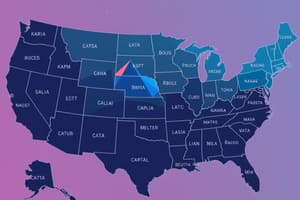Podcast
Questions and Answers
What is the Inflation Reduction Act (IRA)?
What is the Inflation Reduction Act (IRA)?
- A package of new grants and loans to reduce US net GHG emissions (correct)
- A package of new taxes and credits to reduce US net GHG emissions
- A package of new grants and loans to reduce US energy costs
- A package of new taxes and credits to reduce US energy costs
What is the overall size of the package compared to the Build Back Better Act (BBBA)?
What is the overall size of the package compared to the Build Back Better Act (BBBA)?
- Smaller (correct)
- Larger
- About the same
- Not applicable
What are the Clean Air Act Amendments of 1990 also known as?
What are the Clean Air Act Amendments of 1990 also known as?
- The Inflation Reduction Act (IRA (correct)
- The Build Back Better Act (BBBA
- The US Interim Budget and Appropriations Act (IRA
- The US Interim Budget and Appropriations Act (BBBA
What is the highest-emitting sector in the US?
What is the highest-emitting sector in the US?
What are the provisions in the IRA helping to reduce?
What are the provisions in the IRA helping to reduce?
Flashcards are hidden until you start studying
Study Notes
-
The Inflation Reduction Act (IRA) is a package of new grants and loans that drives US net GHG emissions down to 32-42% below 2005 levels in 2030, compared to 24-35% without it.
-
The package of new grant and loan programs, tax credits and emissions fees touches nearly every corner of the US economy and will make meaningful progress toward decarbonizing the US energy system for the next decade and beyond.
-
The overall size of the package is trimmed down compared to the Build Back Better Act (BBBA) passed by the House in November, but the emissions reduction components are still robust and effective.
-
From an economy-wide vantage point, the IRA cuts household energy costs by up to an additional $112 per household on average in 2030 than without it, cuts electric power conventional air pollutants by up to 82% compared to 2021, and scales clean generation to supply as much as 81% of all electricity in 2030.
-
The US Interim Budget and Appropriations Act (IRA) of 2017 contains a number of provisions that drive a step change in decarbonization of the US economy by the end of the decade.
-
These provisions lower the cost of commercial clean technologies like wind and solar, electric vehicles, and building efficiency, enabling them to become more competitive with incumbent fossil fuel technologies and driving a shift towards cleaner energy.
-
The net result of all the provisions in the IRA is that US net GHG emissions decline to 32-42% below 2005 levels in 2030.
-
The IRA changes the game, not just with the deep emissions reductions it generates but also by cutting the cost of additional action by the executive branch and states, which could put the 2030 target within reach.
-
The largest emission reductions in the US come from electric power generation, which is helped by the inclusion of long-term, full-value clean energy tax credits in the "IRA."
-
The policies in the IRA drive clean energy to the highest levels the US has seen in the modern era, and reduce emissions of harmful air pollutants like sulfur dioxide and oxides of nitrogen.
-
Without the IRA, SO2 and NOx emissions would decline by 39-63% and 51-55% below 2021 levels, respectively.
-
The shift to clean energy driven by the IRA cuts SO2 emissions.
-
The Clean Air Act Amendments of 1990, also known as the "IRA", are a set of federal laws that aim to reduce emissions from the US economy.
-
The IRA includes a number of provisions that incentivize clean technology deployment and reduce emissions from the industrial sector.
-
The industrial sector is responsible for a significant portion of US emissions, and the IRA is helping to reduce those emissions.
-
The transportation sector is the highest-emitting sector in the US, and it will take a long time to decarbonize it completely.
-
The IRA includes a number of provisions that incentivize clean technology deployment and reduce emissions from the transportation sector.
Studying That Suits You
Use AI to generate personalized quizzes and flashcards to suit your learning preferences.




